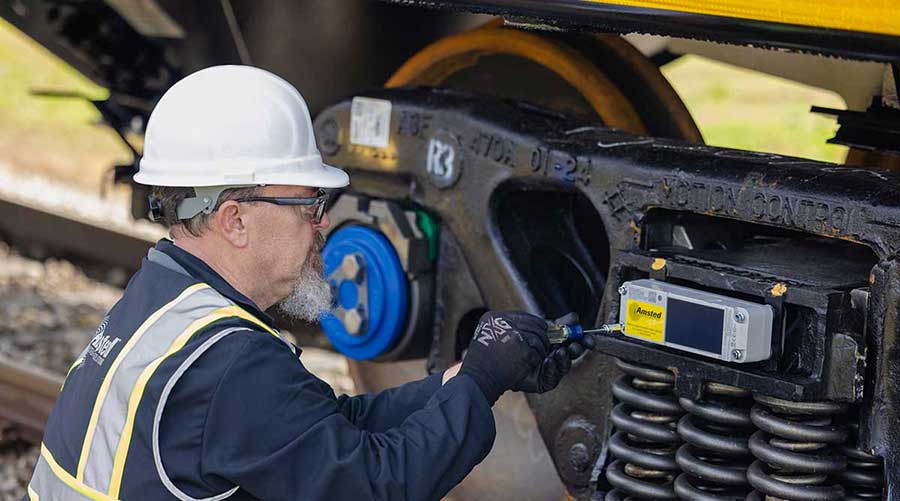Stay updated on news, articles and information for the rail industry
December 2008
Rail News: Rail Industry Trends
Encouraging words from the powers that will be; plus, 'Switchpoints' and the choreography of change (Pat Foran, Context, December 2008)

How post-election Washington responds — to the economic crisis, particularly as it deepens, and rail’s potential restorative role in helping to solve it — in the weeks and months ahead could prompt rail execs to tweak (if not rethink) their ’09 game plans. As of late last month, rail leaders were encouraged by the signals, flares and other communiques they’d received from the powers that will be via meetings with members of President-Elect Barack Obama’s transportation transition team. Mort Downey, a former deputy secretary of transportation under President Bill Clinton, serves as transition chief.
“He knows our issues,” says Association of American Railroads President and CEO Ed Hamberger, who met with the team on Nov. 21. “Mort said, ‘Yeah, yeah, yeah — leave Staggers the way it is. Got it.’”
Not that getting it means measures such as The Railroad Competition and Service Improvement Act (“re-reg” to the rails) are dead in the water; there’s still too much murkiness, post-bailout, to assess the regulatory climate in D.C.
Re-reg, of course, wasn’t the only issue on the table. The freight-rail contingent, which included American Short Line and Regional Railroad Association President Rich Timmons, also urged the incoming administration to factor infrastructure into the next economic stimulus mix; reiterated the “Freight Rail Works” message (“We now move one ton of freight 436 miles on just one gallon of fuel,” as the commercial says); and restated the case for the investment tax credit and Railroad Rehabilitation & Improvement Financing loan programs.
Transit leaders, too, met with Downey and his crew. Officials from the American Public Transportation Association and Community Transportation Association of America discussed economic stimulus and the role public transit investment can play in a recovery package. They also hashed out a host of regulatory issues, including the need for better federal government-transit industry collaboration when it comes to finding ways to simplify, streamline and expedite the federal grant approval process.
“This was a very productive meeting,” says APTA President Bill Millar. “We look forward to a continuing dialogue and working closely with the Obama Administration.”
We’ll follow the dialogue string wherever it leads.
‘SwitchPoints’ and the Choreography of Change
Earlier this year, I was asked to write a book blurb (i.e., testimonial) for the recently published “SwitchPoints: Culture Change on the Fast Track to Business Success.” Loosely, it’s the story of Canadian National Railway Co.’s transformation into what arguably is the best-run railroad in North America. Since I’d written a lot about CN’s cultural evolution during the past decade, I said, “Sure, why not?” And I’m glad I did.
A study in behavioral science that doesn’t skew the least bit academic, “SwitchPoints” was written by two consultants from The Continuous Learning Group Inc., Judy Johnson and Ned Morse; and two CN human resources execs, Les Dakens (who retired earlier this year and is now a consultant) and Peter Edwards.
In considerable detail, the authors discuss the extent to which they applied behavioral science to help clarify the railroad’s new vision and everything that entails, from selecting the proper management tools to assessing impact on profitability to “spiking the switches,” as the authors put it, in order to sustain the new rail culture. As a result, “SwitchPoints” serves as a primer for propagating culture change in the far-flung, steeped-in-history environment that is this thing called “railroading” — if for no reason other than it demonstrates the crucial role rail workers play in nurturing change.
“SwitchPoints” also is supported by data and anecdotes detailing the enlightened journeys various CN managers and employees have taken in recent years. And it’s sprinkled with drop-dead candor from CN President and CEO E. Hunter Harrison. Tonally, that candor is crucial: Nuanced conversation has its place, but cutting to the chase is the first step in any change-and-change-now attempt.
Ultimately, the book is a blueprint for would-be change agents at organizations of any size or ilk. It’s a benchmarking tool strategic thinkers can use as they choreograph their own continuous-improvement courses. “SwitchPoints” is also a good read. Click here for more information. 

Pat Foran, Editor |
Keywords
Browse articles on Railroad Competition and Service Improvement Act Mort DowneyContact Progressive Railroading editorial staff.


 2025 MOW Spending Report: Passenger-rail programs
2025 MOW Spending Report: Passenger-rail programs
 Gardner steps down as Amtrak CEO
Gardner steps down as Amtrak CEO
 Guest comment: Oliver Wyman’s David Hunt
Guest comment: Oliver Wyman’s David Hunt
 Women of Influence in Rail eBook
Women of Influence in Rail eBook
 railPrime
railPrime





